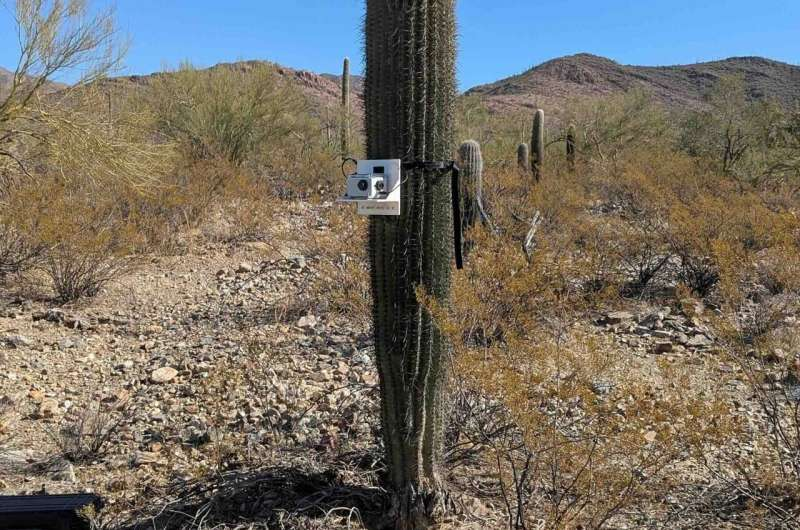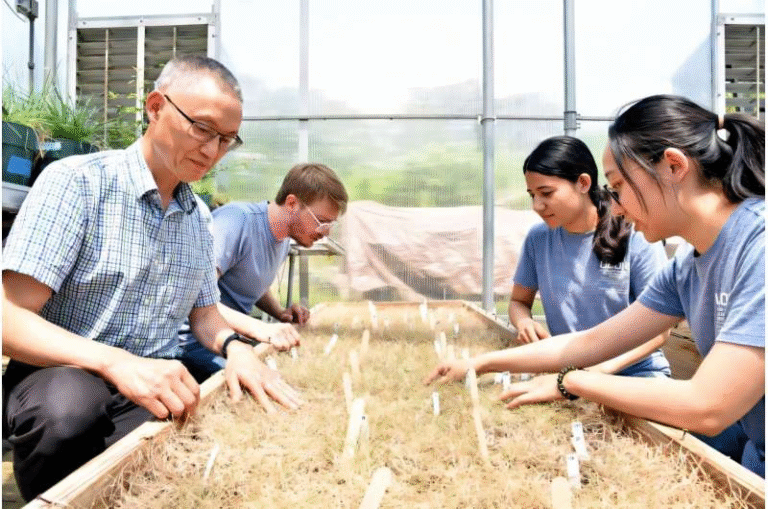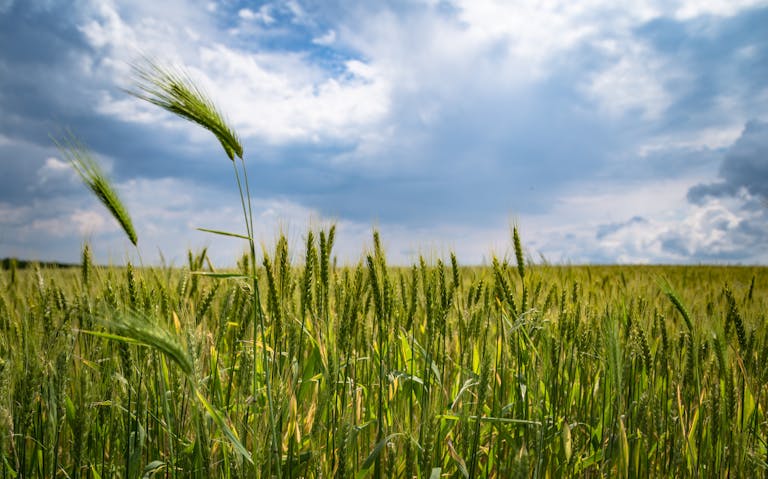Geologist Uses Seismology to Reveal How Giant Saguaros Sway, Bend, and Survive in the Desert

The giant saguaro cactus, native to the Sonoran Desert, is one of the most iconic plants in the American Southwest. Towering up to 70 feet tall and living for centuries, these green giants endure wind, heat, and drought, somehow standing firm through the desert’s extremes. But how exactly do they manage to stay upright? A new study by Jeffrey R. Moore, a geologist at the University of Utah, explores that mystery using a surprising tool — seismology.
In his latest research, Moore applied vibration analysis, a technique commonly used in geology to study how rock formations respond to motion, to living saguaro cacti. His goal was to understand how these massive, water-filled plants move and flex under natural environmental forces such as wind and ground vibrations. The results, published in the American Journal of Botany, reveal fascinating insights about the mechanical and biological resilience of these desert icons.
Applying Earthquake Science to Living Plants
Moore’s background is in geohazard assessment — studying how rock arches, towers, and bridges vibrate under stress. But during a visit to his hometown of Tucson, Arizona, he realized the same tools could be used on something much softer: cacti. Saguaros, like rock pillars, stand tall and face continuous mechanical stress from wind and occasional seismic activity. Yet unlike rock, they’re living, flexible, and filled with water.
To explore this, Moore conducted field experiments in Tucson Mountain Park, a 20,000-acre preserve next to Saguaro National Park. The park authorities gave him permission to work within the area’s natural cactus habitat. Over the course of his study, he selected 11 single-column saguaros, often called “spears” because they lack branching arms, and fitted each with a lightweight seismometer using a simple strap around the stem at chest height.
The device, a Raspberry Shake 3D seismometer, recorded 15 minutes of ambient vibration data from each cactus. This data captured how the cactus naturally swayed and flexed in real-world conditions — nothing artificial, no shaking machines, no cutting. Just the cactus moving as it always does, only now with the motion measured in scientific precision.
The Numbers Behind a Swaying Giant
The vibration data revealed that the resonance frequencies of the saguaros — the specific rates at which they sway — ranged from 0.55 to 3.7 hertz. That means each cactus completes a gentle oscillation less than four times per second. Their damping ratios, a measure of how quickly the movement settles after a disturbance, were between 1 and 2 percent.
Interestingly, Moore found that the stiffness of each cactus changed with height. The base was significantly stiffer, while the upper portions were softer and more flexible, allowing the plant to absorb motion without snapping. Taller cacti were generally stiffer overall but still exhibited softer tops — much like flexible towers or tree trunks.
This mechanical behavior is similar to a cantilever beam, where one end is fixed (in this case, the cactus base rooted in the ground) and the other end is free to sway. However, Moore noted important differences compared to simple engineering models — saguaros showed complex vibration modes and variable stiffness due to their unique internal structure.
The Role of Internal Architecture
A saguaro’s structure is fascinating from an engineering perspective. Inside its fleshy green body lies a framework of woody ribs that act like natural reinforcements. These ribs are thicker and stronger near the bottom, gradually tapering toward the top, matching the variation in stiffness that Moore recorded. The cactus’s outer pleated skin is thick yet elastic, designed to expand dramatically during rainfall and contract during drought.
By observing how these natural structures respond to vibration, Moore’s study connects plant physiology with structural mechanics. The results show that each cactus has a unique vibration signature, reflecting not just its height and thickness, but its internal anatomy and water content.
How Heat and Water Change the Music
One of the most surprising findings was how the saguaros’ vibrations changed throughout the day. Moore initially expected that water content — which varies depending on rainfall and the cactus’s ability to store water — would be the main factor influencing flexibility. But instead, he found daily cycles in the resonance frequencies tied to temperature.
As the desert heated up during the day, the cactus tissue softened slightly, making the plant more flexible and lowering its resonance frequency. At night, as temperatures dropped, the tissues firmed up again, and the frequencies rose. This subtle daily rhythm reveals how living tissues respond to environmental conditions in real time — something that would be invisible without vibration analysis.
Non-Destructive Insights Into Plant Biomechanics
Before this study, researchers who wanted to measure a cactus’s flexibility had to cut sections from it and bend them using weights to calculate stiffness. Not only was that destructive, but it was also limited — you couldn’t easily test the lower stem of a giant cactus without major damage.
Moore’s method, in contrast, is completely non-invasive. It relies on short recordings of natural movement and provides the same kind of data as destructive tests. This opens the door to monitoring plant health and structural integrity without harming the plant, an especially important advancement for species like saguaros that take decades to grow and are protected under law.
Understanding the Saguaro’s Engineering Genius
Saguaros are perfectly adapted to their environment. Their pleated structure allows expansion during monsoon rains — they can absorb and store hundreds of gallons of water — and then slowly contract during dry months. This ability to expand and contract without tearing is part of what makes their vibration behavior so unique. As their internal water levels change, their stiffness and resonance characteristics can shift too.
From an ecological standpoint, saguaros are keystone species of the Sonoran Desert. Many animals, including Gila woodpeckers, elf owls, and white-winged doves, rely on them for shelter and food. Understanding how these plants mechanically respond to stress helps predict how they might endure changing climate conditions, increasing wind events, or even seismic disturbances.
Bridging Two Sciences — Geology and Botany
This research represents a creative crossover between earth sciences and biology. The same vibration techniques used to study rock arches and bridges have now been successfully applied to living plants. It’s a vivid example of how scientific tools developed for one field can illuminate another.
For geologists, it’s a reminder that the principles governing how structures stand and sway — balance, stiffness, frequency, damping — aren’t limited to rocks or buildings. For botanists, it offers a new way to observe plant structure and health dynamically, without cutting or coring.
Moore’s study also suggests that this method could be extended to other large, water-storing plants — such as baobabs or giant cacti in different parts of the world — to compare how structure and hydration influence flexibility.
Constant Motion in a Still Desert
Even when the desert feels completely still, saguaros are always in motion. They’re constantly vibrating — sometimes barely perceptibly — responding to every gust of wind, every shift of air, every small tremor of the earth beneath them.
Moore’s study gives us a way to see that hidden movement and appreciate these plants not just as static icons of the desert, but as living, dynamic structures constantly adjusting to the forces around them.
This research doesn’t just deepen our understanding of saguaros — it reshapes how we think about the intersection of life and physics.
Research Reference:
Jeffrey R. Moore (2025). In situ ambient vibration modal analysis of saguaro cacti (Carnegiea gigantea). American Journal of Botany. https://doi.org/10.1002/ajb2.70116





